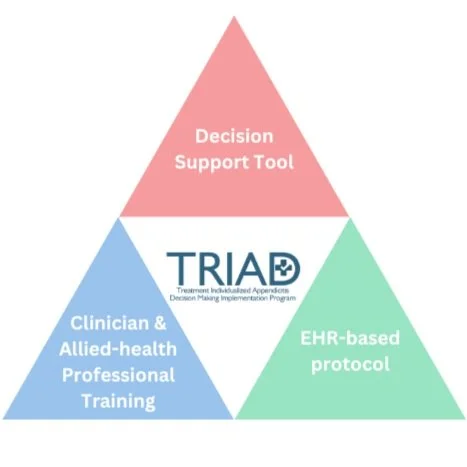About TRIAD
The appendix is a tiny, finger-like tube that’s attached to the end of the large intestine. If it becomes blocked or swollen, it can become infected. The blockage can be caused by many things, an illness, thick mucus, hard stool, or a tumor. (can we add a picture of an appendix here?)
The first symptom is often pain around the belly button or mid upper abdomen. Pain may be minor at first, but becomes more sharp and severe. People may also have a loss of appetite, nausea, vomiting, and a low-grade fever. Appendicitis is one of the most common causes of abdominal pain. It affects both men (8.6%) and women (6.7%)., most often between the age of 10 and 30 years old.
For years, surgery has been the preferred treatment for appendicitis. However, surgery may not be right for everyone. Like all surgical procedures, there are risks, discomfort, and time required for recovery. For many, the out-of-pocket costs for emergency surgery can have devastating financial consequences. Over the past 15 years, multiple randomized studies comparing antibiotics alone to appendectomy have demonstrated that a nonoperative approach is an effective alternative to appendectomy, albeit resulting in 25%–30% of patients having an appendectomy by 90 days, and as many as 50% having surgery in 3 to 5 years.(CODA Collaborative, Flum DR, Davidson GH, Monsell SE, et al. A randomized trial comparing antibiotics with appendectomy for appendicitis. N Engl J Med. 2020;383(20):1907-1919.)
These two treatment options have a unique set of risks and benefits and all patients should be fully informed about their options so they can make a decision with their doctors that is best for them.
TRIAD aims to:
Increase Awareness of Treatment Options for Appendicitis
This is a crucial first step towards informed decision-making. Patients need to understand the pros and cons of different treatment options to make a decision that aligns with their values and preferences. It's important to consider different factors such as patient age, overall health, and the severity of the condition when discussing treatment options. Improve experience with decision-making Appendicitis can be a stressful and overwhelming experience for patients, and decision-making can be challenging under these circumstances.Improve Experience with Decision-Making
A good decision-making process involves providing patients with clear and accessible information about their options, ensuring that they feel heard and understood, and addressing any concerns or questions they may have. It also involves providing evidence-based support to help ensure the safest and most beneficial treatment for their patients within the very hectic and fast-paced environment of the emergency room.Implement a Decision Support Tool
A Decision Support Tool can help patients navigate the decision-making process by providing them with relevant information and guiding them through the pros and cons of different treatment options. It can also help healthcare providers ensure that patients are fully informed and that their decisions are aligned with their values and preferences.


